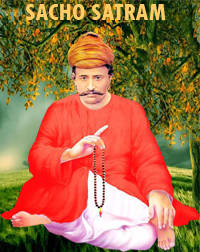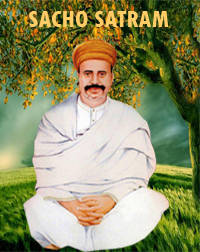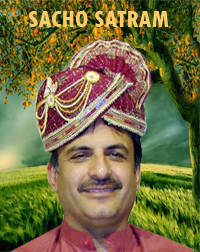In one of the enlightening Satsangs, Hazir Swaroop Sai Sadhram Saheb graciously explained the profound significance of the Sehra, which is tied to the groom’s head or worn by him. He emphasized its deep spiritual importance as an auspicious wedding ritual.
This symbolic shift in responsibility is beautifully represented by adorning the groom with the Sehra on his wedding day. More than a decorative piece, the Sehra embodies the groom’s solemn vow to uphold his responsibilities, guiding his household with wisdom, strength, and grace. It signifies the couple’s commitment to each other and their duties towards society, relatives, friends, and well-wishers.
There was a time when the Sehra was placed on the groom’s head with great reverence after performing sacred rituals. The groom was expected to keep the Sehra on until the wedding ceremonies were completed.
The Sehra Bandi ritual was conducted with deep respect, with a Pandit specially invited to perform the sacred ceremony. Family members, relatives, and friends gathered to celebrate the occasion with joy, singing, dancing, and showering the groom with blessings and congratulations.
After the Sehra Bandi ceremony, the groom, adorned with the beautifully decorated and sacred Sehra, proceeded to the Phera ritual. Once the wedding ceremonies concluded, the Sehra was either treasured as a lifelong keepsake or, if the wearer was unable to fulfill his responsibilities, respectfully offered to the river on an auspicious day. It was regarded as a symbol of dignity and an honorable souvenir for the groom.
Saijan shared his concern that, unfortunately, many youngsters today lack reverence for traditional rituals and often disregard their significance. This is primarily because children are not taught the fundamental values of Dharma from an early age. Even those grooms who wear the Sehra often do so without understanding its true meaning or how it should be preserved.
Many people carelessly discard their Sehra after the wedding, considering it insignificant. However, disrespecting such a sacred symbol may unknowingly create obstacles in one’s path, affecting progress, prosperity, and even marital harmony.
The Sehra symbolizes honor, faith, trust, and well-being, serving as a reminder to the groom of his responsibilities toward his family, friends, relatives, society, and profession. Saijan recounted attending weddings where the **Sehra** was either overlooked or entirely omitted, as it held no significance for those involved in the ceremony.
Hazir Swaroop Sai Sadhram Saheb emphasized the importance of focusing on essential aspects of life, such as Dharmic rituals, duties toward elders, respectful behavior, mindful eating, honoring Pandits, and performing pujas and Paths with full reverence. He explained that our focus shapes our experiences—when we direct our attention toward meaningful aspects, we invite harmony and growth into our lives. Conversely, if our attention is consumed by indulgent festivities or inauspicious activities during a wedding, the outcome may not be favorable. Since marriage is a profoundly sacred event, we must uphold its spiritual purity and deeper significance.
Understanding and respecting the wisdom behind our rituals helps protect us from unnecessary difficulties, ensuring a smooth and obstacle-free life. Dharma’s rituals are not mere traditions but timeless pathways to a harmonious life. True understanding comes only with the wisdom of a spiritual Guru and the light of Dharmic education.



